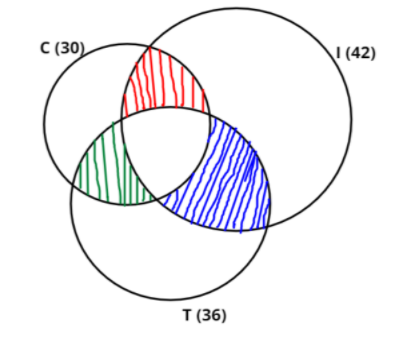Question
Question: A group of 123 workers went to a canteen for coffee, ice-cream and tea. 42 workers took ice-cream, 3...
A group of 123 workers went to a canteen for coffee, ice-cream and tea. 42 workers took ice-cream, 36 took tea and 30 took coffee, 15 workers purchased ice-cream and tea, 10 ice-cream and coffee and 4 coffee and tea but not ice-cream, while 11 took ice-cream and tea but not coffee. Determine how many workers did not purchase anything?
Solution
We will proceed in this problem by making a venn diagram of the problem.
Let consider three sets i.e., C, I and T which represents the workers purchasing coffee, ice-cream and tea respectively.
Complete step-by-step answer :

Total number of workers=123
Number of workers purchasing ice-cream, n(I)=42
Number of workers purchasing tea, n(T)=36
Number of workers purchasing coffee, n(C)=30
Number of workers purchasing ice-cream and tea, n(I∩T)=15
Number of workers purchasing ice-cream and coffee, n(I∩C)=10
Number of workers purchasing only ice-cream and tea but not coffee (shown in the figure through blue coloured hatched lines) is given by
n(I∩T)−n(I∩T∩C)=11⇒15−n(I∩T∩C)=11⇒n(I∩T∩C)=15−11=4
Number of workers purchasing only coffee and tea but not ice-cream (shown in the figure through green coloured hatched lines) is given by
n(T∩C)−n(I∩T∩C)=4⇒n(T∩C)−4=4⇒n(T∩C)=8
As we know that for any three sets i.e., C, I and T, we can write
n(I∪T∪C)=n(I)+n(T)+n(C)−n(I∩T)−n(T∩C)−n(I∩C)+n(I∩T∩C) →(1)
Now substituting all the values in equation (1), we get
Number of workers purchasing either ice-cream or tea or coffee is given by
n(I∪T∪C)=42+36+30−15−8−10+4=79
Since, Number of workers who did not purchase anything is equal to the total number of workers minus the number of workers purchasing either ice-cream or tea or coffee.
Number of workers who did not purchase anything=123−79=44.
Note : In these types of problems, a venn diagram is used to calculate all the unknowns. In this particular problem, we used the given data to determine the unknowns in equation (1).
